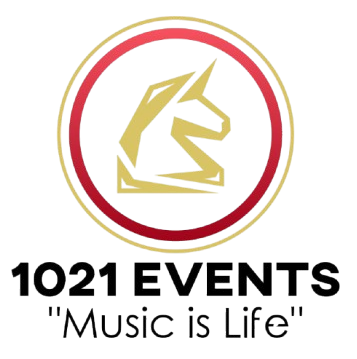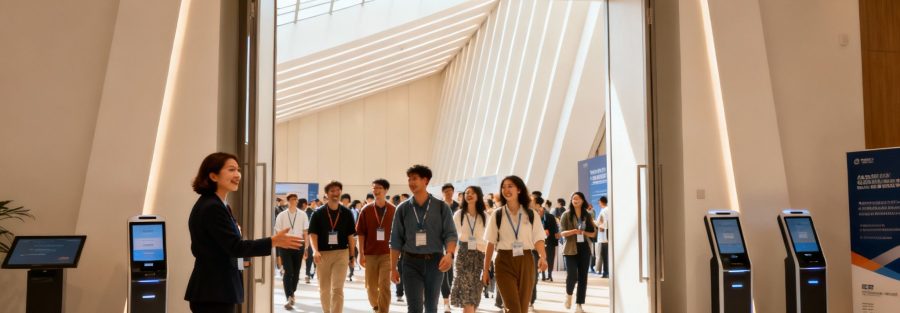Want to boost your event turnout? The secret isn't a bigger ad budget. It's about creating an event people are genuinely afraid to miss. You do that by nailing down your goals and getting inside the head of your ideal attendee before you even think about promotion. This is where you figure out the real value you're offering and who you’re offering it to.
Building an Event People Actually Want to Attend
Long before you send the first email or post a single tweet, your event’s fate is already being decided. So many organizers jump right into marketing, then scratch their heads when the sign-ups trickle in. The problem usually isn't the promotion; it's a weak concept from the get-go. A sold-out event isn't just marketed well—it's designed from the ground up for a specific person with a specific purpose.
This early stage is all strategy, not logistics. It's about asking the hard questions now to avoid a half-empty room later. This is where you build the "why" that informs every single decision, from the speakers you book to the price on the ticket.
First, Define Your Event's Core Purpose
What does a "win" look like for you? Answering that question is your north star. Without a clear goal, your planning will feel scattered, and your message will be generic. Your main objective will likely fall into one of these buckets, and each one creates a totally different event.
- Lead Generation: Is this all about stocking your sales pipeline? Then your event needs to be a problem-solving machine for your ideal customer. Think practical workshops, clear calls-to-action, and built-in opportunities for your sales team to connect.
- Community Building: Are you trying to bring your tribe together? Forget stuffy lectures. Your focus should be on interactive sessions, tons of networking breaks, and shared experiences that make people feel like they belong.
- Education and Thought Leadership: Want to be seen as the undisputed expert in your field? You’ll need to deliver exclusive, high-value content from industry heavyweights—the kind of stuff people can't just Google.
Key Takeaway: Stop trying to be everything to everyone. Pick one primary goal and knock it out of the park. A focused event is far more powerful than one that tries to do a little bit of everything.
This infographic really captures how to sketch out your event blueprint, starting with those core goals and then zeroing in on your perfect attendee.
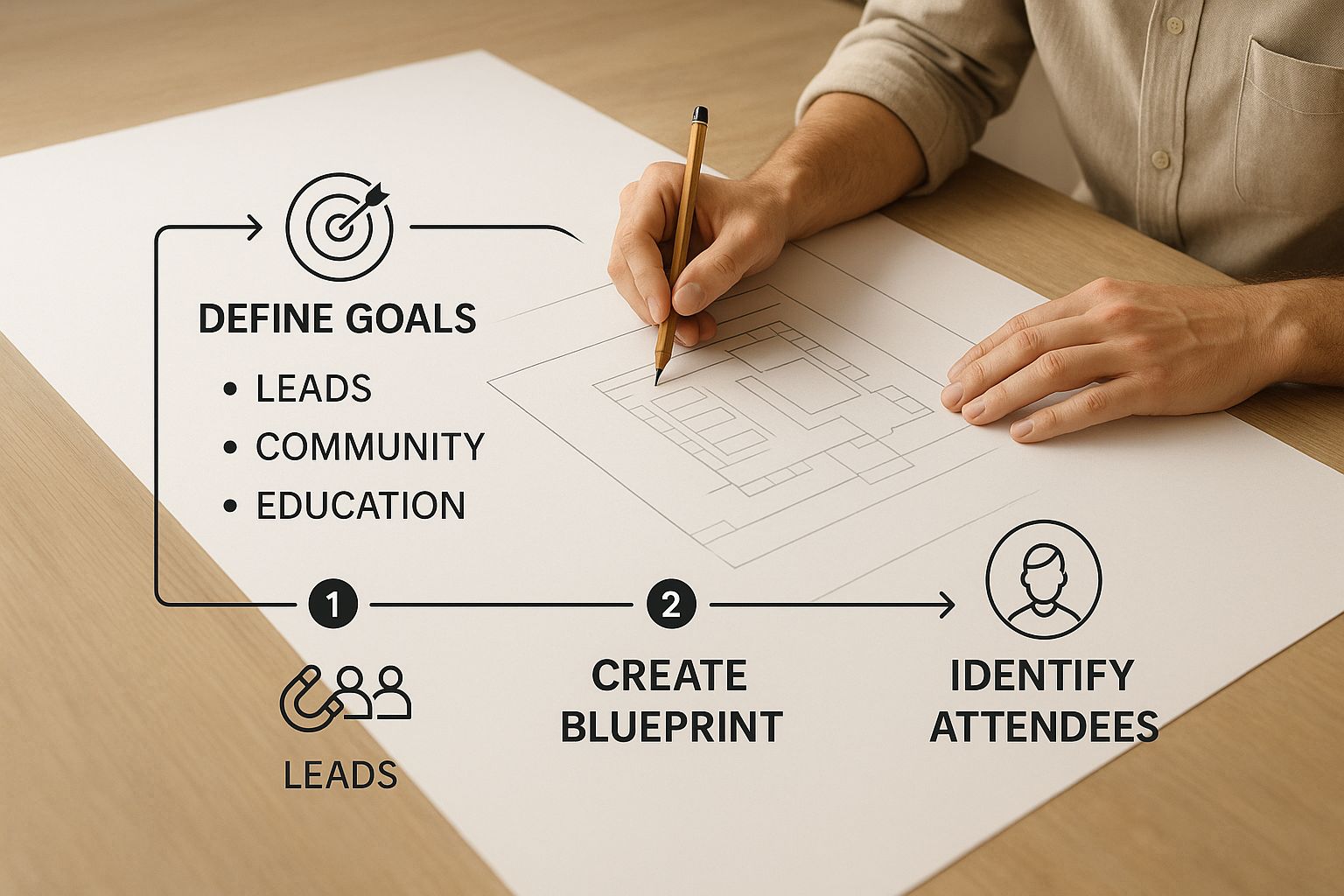
Seeing it laid out like this makes it clear: a great event is built layer by layer, with each step making the next one easier.
Pinpoint Your Ideal Attendee with Precision
Okay, you know your "why." Now it's time for your "who." Seriously, creating a detailed profile of your ideal attendee is probably the most important thing you'll do. And I don't just mean basic demographics.
What are their biggest headaches at work? What career goals are they chasing? When you understand their real motivations, you can design an experience that feels like it was made just for them. A generic invite to a "marketing conference" is easy to delete. But an invitation to a workshop that promises to solve their biggest lead attribution nightmare? That gets their attention.
This deep dive into your audience is the foundation of your entire plan. For a more detailed breakdown, you can check out our full guide on how to plan an event from start to finish. When you know your attendees inside and out, every choice—from the session topics to the kind of coffee you serve—will hit the mark and make coming to your event feel less like an option and more like a necessity.
Your Multi-Channel Event Promotion Playbook
So you've got a fantastic event idea. That's the easy part. Now, how do you get people to actually show up? A great idea with no promotion is like throwing a party and forgetting to send out the invites. This isn't about just blasting your message everywhere; it's about building a smart, integrated campaign where every channel works together to create some serious buzz.
The real goal here is to guide people from a casual "Oh, that looks interesting" to a frantic "I need to get my ticket now." Let's walk through how to build a promotional machine that does exactly that.
Nail Your Email Marketing Cadence
Don't let anyone tell you otherwise: email is still the king of event promotion. It delivers a massive ROI, but only if you do it right. Firing off a single "Registration is Open!" email and calling it a day just won't cut it.
You need to think like a storyteller. Your first email should be all about the big announcement, packed with energy and excitement. From there, each follow-up should peel back another layer—spotlight a killer speaker, reveal a can't-miss session, or share a glowing review from last year's event. As the date gets closer, you can start creating a little friendly urgency with reminders about early-bird pricing ending or a "last chance" for tickets.
A great email campaign doesn't just inform; it makes the value of attending so painfully obvious that your subscribers feel like they'd be making a huge mistake if they didn't go.
Create Social Media Content People Actually Want to Share
Social media is where your event's personality comes to life. This is your chance to build a real community and get people talking. Forget just posting registration links—you have to give them something worth sharing.
Here are a few tactics I've seen work wonders:
- Speaker Spotlights: Whip up some sharp graphics with a powerful quote and a great photo for each speaker. Make sure to tag them and their companies to get them to share it with their own followers.
- Behind-the-Scenes Glimpses: People love feeling like insiders. Show them snippets of the venue being prepped, your team in a planning session, or a sneak peek of the swag bags. It feels real and authentic.
- Interactive Posts: Get people involved! Run a poll asking which breakout session they're most hyped for, or host a live "Ask Me Anything" (AMA) with your keynote speaker on Instagram.
The secret is to create content for your audience, not for you. When you focus on being helpful, interesting, or entertaining, the shares and registrations will naturally follow.
Expert Tip: Never underestimate the power of a strong visual identity. When your colors, fonts, and logos are consistent across every channel, your event becomes instantly recognizable and feels far more professional. For some practical inspiration, check out these powerful event branding ideas to make your promotions pop.
A unified look and feel is the glue that holds your entire campaign together, building trust with every post, email, and ad.
Your Pre-Event Promotional Channel Mix
Choosing the right channels is half the battle. You can't be everywhere at once, so focus your energy where it will have the most impact. This table breaks down some of the most effective channels to help you build a balanced promotional plan.
| Channel | Best For | Key Metric | Pro-Tip |
|---|---|---|---|
| Email Marketing | Nurturing warm leads and driving direct ticket sales from your existing audience. | Click-Through Rate (CTR) | Segment your list. Send tailored messages to past attendees, people who abandoned cart, etc. |
| Organic Social | Building community, creating buzz, and sharing behind-the-scenes content. | Engagement Rate | Don't just broadcast. Ask questions, run polls, and reply to every single comment to spark conversations. |
| Paid Social Ads | Reaching new, highly targeted audiences who don't know you exist yet. | Cost Per Registration | Use retargeting! Show a special offer to people who visited your event page but didn't buy a ticket. |
| Partnerships | Tapping into new audiences and borrowing credibility from trusted brands or influencers. | Referral Traffic | Make it ridiculously easy for partners to promote you. Give them pre-written copy and custom graphics. |
Think of this as your starting lineup. You might add or subtract players depending on your specific event and audience, but this mix provides a powerful foundation for driving registrations.
Drive Registrations with Targeted Ads
Organic reach is fantastic, but paid ads are how you scale. Platforms like Facebook, Instagram, and LinkedIn have incredibly powerful targeting tools that let you put your event right in front of your dream attendees.
Start by building audiences based on things like job titles, industry, or interests relevant to your event. Then, get crafty with retargeting. You can show specific ads to people who visited your registration page but got distracted before finishing. These folks are already interested; sometimes all they need is a little nudge, like an ad highlighting a key benefit or offering a small, time-sensitive discount.
Lean on Your Partners and Collaborators
Why build an audience from scratch when you can borrow one? Strategic partnerships are one of the fastest ways to pour fuel on your promotional fire. Think about your speakers, sponsors, or even other companies who serve the same audience but don't directly compete with you.
Ask your speakers to share that they're participating. Better yet, give them a promo toolkit with pre-written social media posts and custom graphics to make it a no-brainer for them. You can also explore powerful strategies like influencer marketing for events to get your event in front of established, trusted communities.
Even something as simple as a co-hosted webinar or an email swap with a partner can introduce your event to thousands of new, qualified people. It’s a classic win-win.
Expand Your Reach with Hybrid and Virtual Options
If your event is only happening in one physical place, you're leaving a massive audience on the table. Think about it: travel costs, packed schedules, and just plain distance are huge hurdles for a lot of people who would otherwise love to be there. Going hybrid or fully virtual isn't just a pandemic hangover—it's a smart, strategic way to tear down those barriers and open the floodgates for attendance.
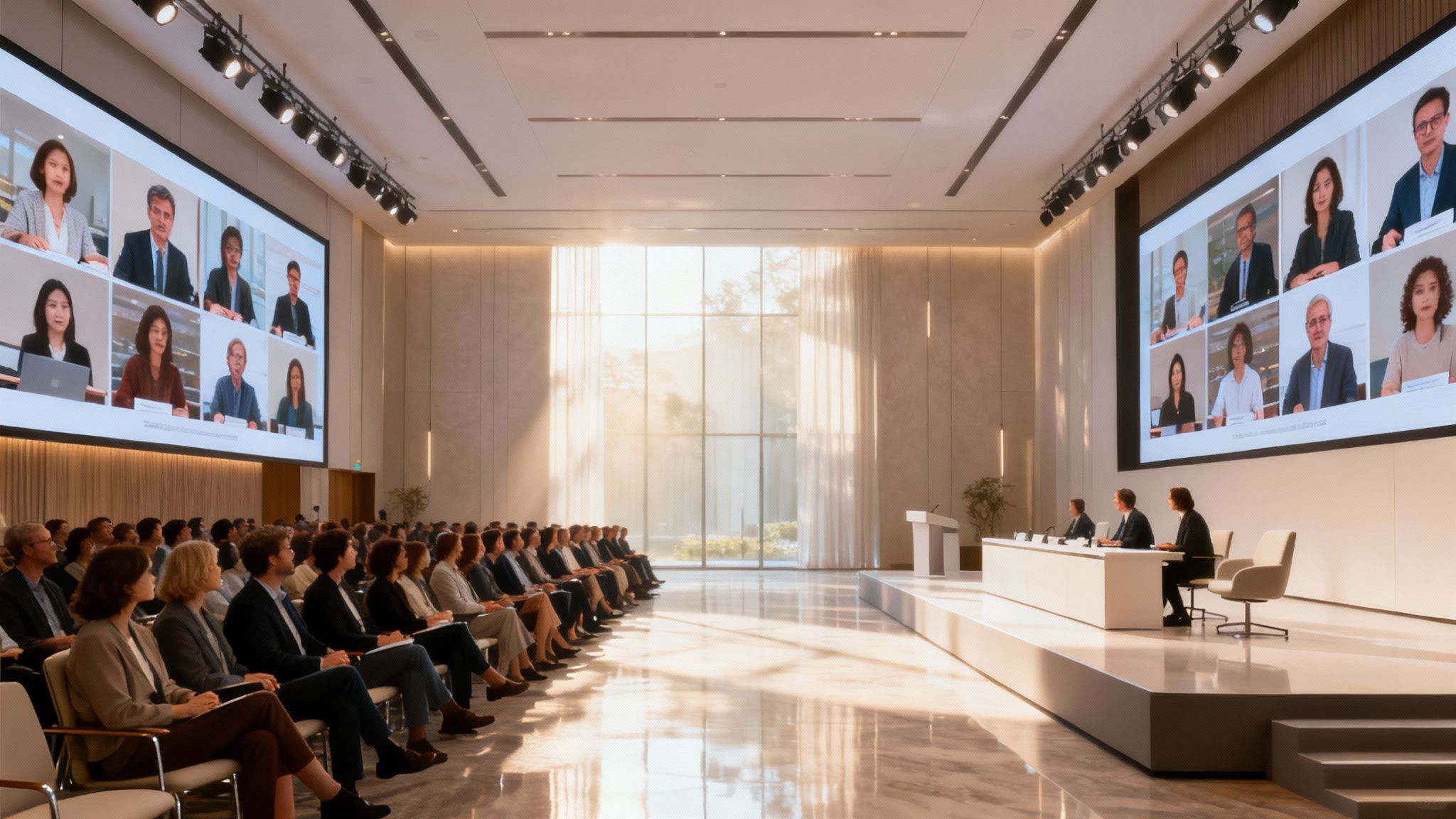
Suddenly, your event is accessible to anyone with a decent internet connection. You're meeting people where they are, giving them the flexibility to soak up your amazing content without having to book a flight.
Why a Virtual Component Is a Game-Changer
Offering a virtual ticket does more than just stream a few sessions; it creates a whole new front door to your event. For so many potential attendees, the time and money needed for travel are complete non-starters. A virtual option just erases that friction and pulls in a whole segment of your audience that you’d otherwise never reach.
The numbers don't lie. The virtual event market is absolutely exploding, with some projections showing it could hit $537.18 billion by 2029. We're seeing engagement rates hit 60–70%, and virtual attendees are often spending 27% more time engaged than their in-person counterparts. Why? Because a staggering 80% of them are there purely for the educational content. The demand is clearly there.
But this is about more than just boosting your registration numbers. It’s about being inclusive. A virtual component welcomes people with mobility challenges, caregiving duties, or smaller budgets, showing that your brand is for everyone.
Crafting an Engaging Online Experience
I've seen so many organizers make this mistake: they treat their virtual audience like an afterthought. You can't just point a webcam at the stage and call it a day. The online experience has to feel just as intentional and valuable as being there in person. Your job is to deliver the core value—the learning and the connections—right through their screen.
Here’s how to build an online experience that people will actually stick around for:
- Broadcast-Quality Production: Invest in solid audio and video. Nothing makes people click away faster than a choppy stream or muffled sound. A professional setup shows your remote attendees you actually care about their experience.
- Keep Them Involved: Don't let them just passively watch. Use tools like live polls, dedicated Q&A sessions, and lively chat channels to keep the online audience hooked and participating.
- Get a Dedicated Virtual Host: Having an MC just for the virtual crowd is a brilliant move. They can guide the online audience, spark discussions, and make sure everyone feels seen and included.
Pro Tip: I always tell clients to think of a hybrid event as two distinct shows running at the same time. The people in the room get the live energy, while the virtual audience gets a polished, interactive broadcast. Both experiences should feel premium.
Pulling this off is no small feat. To make sure everything runs smoothly for both audiences, it's often a good idea to look into professional hybrid event production services that live and breathe this stuff.
Don't Forget Networking for Remote Attendees
Let’s be honest, networking is one of the biggest reasons people go to events. Recreating that "hallway conversation" vibe online takes some real effort, but it’s totally doable and makes a world of difference. Just opening a chat window and hoping for magic isn't a strategy.
You need to engineer moments for connection. Look for event platforms with built-in networking tools that can set up one-on-one video calls or themed breakout rooms. For example, you could host a "virtual roundtable" on a hot topic, letting a small group of remote attendees really connect and trade ideas.
Another great tactic is to play matchmaker by connecting attendees based on their professional interests or goals. This kind of curated networking adds a ton of value and proves to your remote audience that you're invested in helping them build real connections, no matter where they are. It’s how you turn a passive viewing experience into an active, unforgettable one.
Designing an Unforgettable Attendee Experience
Getting people to register is a huge win, but that’s only half the battle. The real magic—the stuff that turns attendees into lifelong fans who bring their friends next year—happens on the day of the event. A truly unforgettable experience isn't about expensive gimmicks; it's about making every single person feel seen, valued, and genuinely welcome.
This is your chance to prove you didn't just want their registration fee. You wanted them to be there. By focusing on thoughtful details and seamless execution, you create an atmosphere where people can finally relax, connect, and soak up the value you promised.
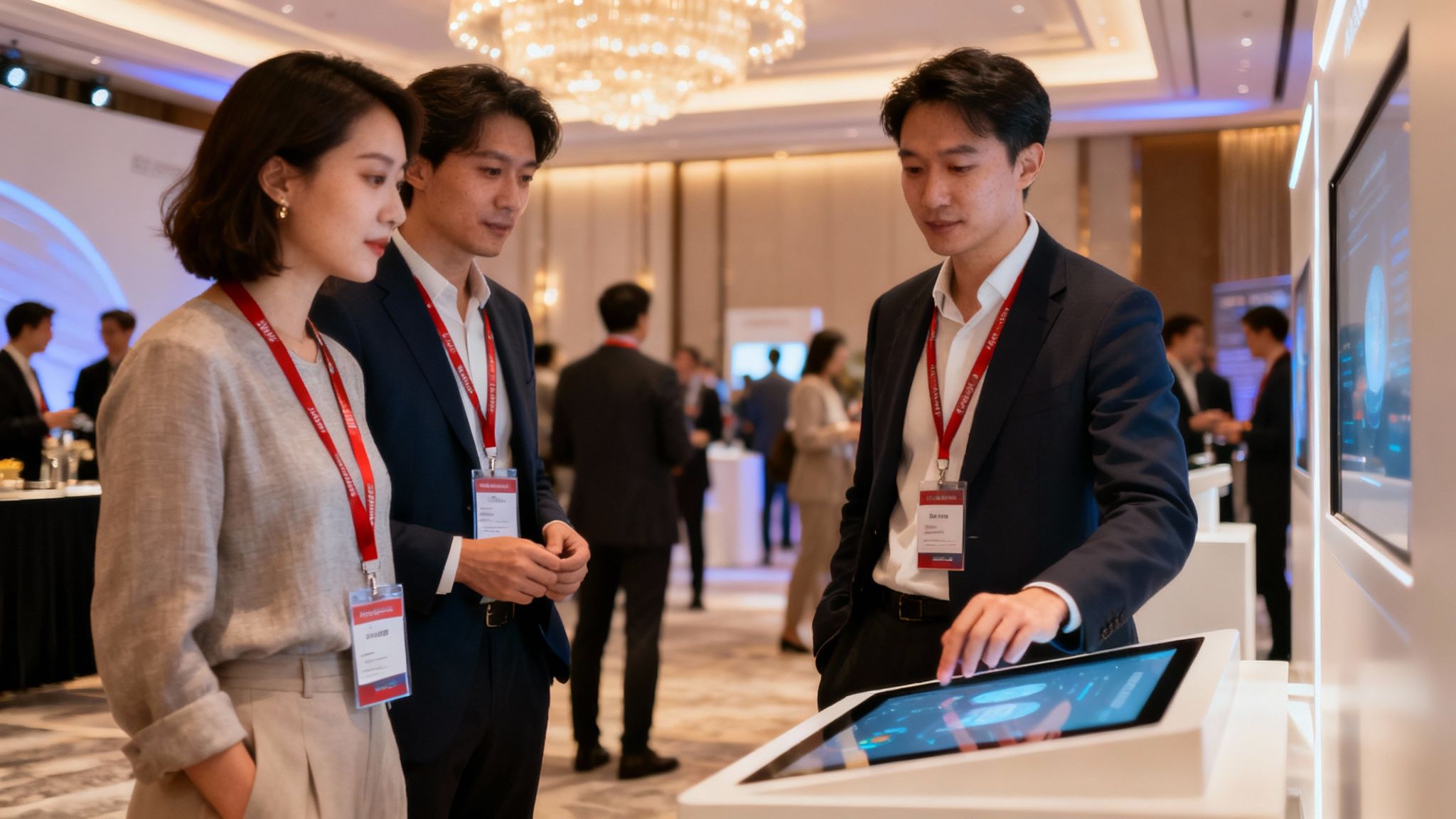
Make the First Impression Count
The attendee experience kicks off the second they arrive, whether they’re walking into a venue or hitting a virtual login screen. A frustrating, confusing, or slow entry can sour their mood before your first speaker even takes the stage. The goal here is a smooth, welcoming, and efficient start.
A clunky check-in process is an easy pitfall to avoid. For on-site events, look into the best check-in apps for events that let people get through the door with a quick scan of their phone. This small investment pays off big time by killing long lines and starting the day on a positive note.
Personalization Is the New Standard
Today's attendees expect more than a one-size-fits-all agenda. They're looking for experiences that feel relevant to their specific goals and interests. Personalization shows you understand your audience on a deeper level, transforming a generic event into a personal journey for each guest.
This isn’t just a nice-to-have; it’s a powerful driver of satisfaction and loyalty. The data backs this up—an incredible 96% of marketers saw a jump in sales after adding personalized elements to their events. On top of that, 64% of attendees now prioritize immersive, tailored experiences over cookie-cutter sessions. When you get this right, you leave a lasting impression.
Here are a few ways to add that personal touch:
- Customized Agendas: Let attendees build their own schedule in the event app based on different tracks like "Beginner," "Advanced," or by industry.
- Smart Networking: Use event tech to suggest relevant connections based on attendees' professional profiles and stated goals. No more random wandering.
- Personalized Swag: Instead of one generic t-shirt, let attendees choose from a few different items or colors. It’s a small detail that shows you care.
Engineer Moments of Connection and Delight
People come to events for the content, but they come back for the connections. Your job is to create an environment where networking feels natural and fun, not forced and awkward. Think beyond the standard coffee break and intentionally design spaces and activities that spark conversation.
I once attended a conference that replaced a boring cocktail hour with "themed lounges." There was a "Marketing Geeks" corner, a "Startup Founders" hub, and a "Creative Minds" space. It was brilliant because it gave everyone an instant, low-pressure way to find their people.
This is where you can get really creative. Our guide on https://1021events.com/interactive-event-ideas/ is packed with inspiration, from live polling to collaborative art installations.
Don't forget the entire sensory experience. What does the venue look, sound, and even smell like? Simple touches like great background music, comfortable seating, and readily available charging stations remove friction and show you’ve thought about attendee comfort. These small details add up, creating a powerful, positive impression that people will remember long after the final session ends.
Keeping the Momentum Going After the Event Ends
When the final applause fades, your job isn't over. In fact, one of the most important phases is just beginning. The energy you've built up is a massive asset, but it disappears fast. What you do next is what separates a forgettable one-off from an event brand that builds a loyal community, one that’s already excited for your next announcement.
This is your golden window to cement relationships, show attendees you're listening, and keep the buzz going. A killer follow-up plan is absolutely essential for boosting attendance at future events because it keeps your newly engaged audience right where you want them: engaged.
Gather Feedback That Actually Matters
Get that feedback survey out the door within 24 hours. Seriously, don't wait. The experience needs to be fresh in everyone's mind.
But please, don't just ask, "Did you have a good time?" That tells you almost nothing. To get insights you can actually use, you have to dig deeper.
Try asking specific, open-ended questions that make people think:
- What was the single most valuable thing you learned or experienced?
- Which session felt like a miss, and why didn't it connect with you?
- If you had a magic wand, what's one thing you would change about the event?
- On a scale of 1-10, how likely are you to recommend this to a colleague? (This is your Net Promoter Score, or NPS, and it's gold.)
These kinds of questions get you past the generic star ratings and into the nitty-gritty of what worked and what didn't. This is the real, actionable data you need when you're figuring out how to measure event success in a way that actually helps you grow.
Squeeze Every Last Drop Out of Your Content
Think about it—your event just produced a mountain of amazing content. Don't just let it sit on a hard drive somewhere. Repurposing that material is the single best way to keep delivering value and give the folks who couldn't make it a serious case of FOMO.
Your goal is to stretch the event's impact from a few days to a few months.
A single keynote, for example, is a content goldmine.
| Original Content | Can Be Turned Into… |
|---|---|
| Full Session Recording | A "Best Of" highlight reel for social media, or an audio-only version for a podcast. |
| Speaker's Slide Deck | A post on SlideShare, or individual slides turned into quote graphics for Instagram and LinkedIn. |
| Key Quotes & Stats | A whole series of punchy Twitter posts, or a slick infographic that sums up the big ideas. |
Every piece of repurposed content you share is a tiny commercial for your next event, constantly reminding people of the quality you deliver.
Build Your Tribe
The people who just walked out your door are your hottest leads for the next event. The trick is to keep them engaged without immediately hitting them with another sales pitch. It's all about continuing the conversation and giving them more value.
My Takeaway: I always tell my clients to build a simple "post-event content hub." It's just a private page on their website where attendees can find all the session recordings, slides, and any bonus materials. It becomes a go-to resource that keeps them coming back.
Start with a "thank you" email that links directly to this hub. Then, invite them to an exclusive LinkedIn or Facebook group where they can keep networking with each other and the speakers.
When you focus on building a community instead of just closing out a transaction, you're building a loyal following. By the time you announce your next event, this group won't just know about it—they’ll be the first ones rushing to get tickets.
Your Top Event Attendance Questions, Answered
Alright, you've got your big idea and a solid plan taking shape. But let's be real—it's the nitty-gritty questions that can really keep you up at night. How do you nail the timing? What if the budget is tight? And what about those frustrating no-shows?
Here are the straight-up answers to the questions we hear all the time from event organizers in the trenches.
How Far in Advance Should I Start Promoting My Event?
This is the big one, and the honest answer is: it depends. There’s no magic number, but experience gives us some pretty reliable guidelines.
For a large conference, you’ll want to kick off your main promotional push 3-4 months before the doors open. This gives you enough breathing room to build real momentum. You can launch with a big announcement, roll into an early-bird special, and then fill the final weeks with speaker reveals and sneak peeks of the content.
But for smaller gigs like a local workshop or a webinar, a 6-8 week runway is often the sweet spot. It’s long enough to get on people's radar but not so long that they forget about it.
Now, if you're planning a major international event where people need to book flights and get budget approvals from their bosses, you have to think much further ahead. Get a "save the date" announcement out 6-12 months in advance. You need to claim a spot on their calendar before it fills up.
What Are the Best Low-Cost Ways to Get More People to Show Up?
You don't need a Hollywood-sized budget to pack the house. Honestly, some of the most powerful moves for boosting attendance are scrappy, smart, and focus more on people than paid ads.
Your absolute best tool is the email list you already have. These are people who know you and trust you, and sending them a targeted campaign costs you nothing. Beyond that, here are a few other power moves that won't break the bank:
- Go All-In on Organic Social: Create content that people actually want to share. Ask your speakers, sponsors, and even your own team to spread the word. A single share from a well-connected industry voice can be worth more than a dozen paid ads.
- Launch a Referral Program: It’s a classic for a reason—it works. Offer a small discount or a cool perk to anyone who gets a friend to sign up. A recommendation from a peer is infinitely more trustworthy than an ad.
- Find Strategic Partners: Who else talks to your audience? Team up with non-competing companies or community groups. A simple cross-promotion in each other's newsletters can get your event in front of thousands of new, qualified people for free.
My Two Cents: Your biggest fans are your best marketers. Give them an easy-to-share link, some pre-written social media copy, and a small incentive. Then just get out of the way and let them work their magic. It's authentic, effective, and incredibly budget-friendly.
How Do I Re-Engage People Who Registered but Didn't Attend?
First things first: don't give up on them! A no-show isn't a lost lead; they were interested enough to sign up in the first place. Something just got in the way. A little thoughtful follow-up can easily turn that missed connection into a future attendee.
Start by sending a friendly "Sorry we missed you!" email. The trick is to provide immediate value right in that message. Don't just say you missed them—give them a link to the session recordings, the presentation slides, or a quick blog post with the key takeaways. It’s a simple gesture that shows you’re still thinking about them and reinforces the value your event offers.
After that, you can:
- Offer an exclusive "welcome back" discount for your next event. It acknowledges their initial interest and gives them a good reason to follow through next time.
- Tag them in your CRM as a "registered no-show." This lets you send them super-targeted content down the line, maybe even a quick survey asking what held them back.
- Keep them in the loop. Don't let the relationship go cold. Make sure they keep receiving your valuable newsletters and content so you stay top-of-mind for the next event.
Is It Better to Offer Early Bird Discounts or Group Discounts?
Why not both? This isn't an either/or decision. Think of them as two different tools in your promo kit, each used to solve a different problem at a different time.
Early bird discounts are all about building that crucial initial momentum. They reward your most enthusiastic followers and—just as importantly—get cash flowing into your bank account early on. That first wave of sign-ups also creates powerful social proof, making it easier to convince everyone else to jump on board.
Group discounts, on the other hand, are your secret weapon for scaling up ticket sales later in the game. They turn one interested person into a champion for your event inside their own company or friend group. This is how a single sale can multiply into three, four, or even more.
The smart play is to lead with a strong early-bird offer to kick things off. Once that deadline passes, pivot your messaging and roll out the group discount to keep the sales engine humming right up until event day.
At 1021 Events, we live for the details that turn a good event into an unforgettable one. From flawless sound to jaw-dropping visuals, we bring the production magic that makes people talk. See how we can help you sell out your next event at https://www.1021events.com.
